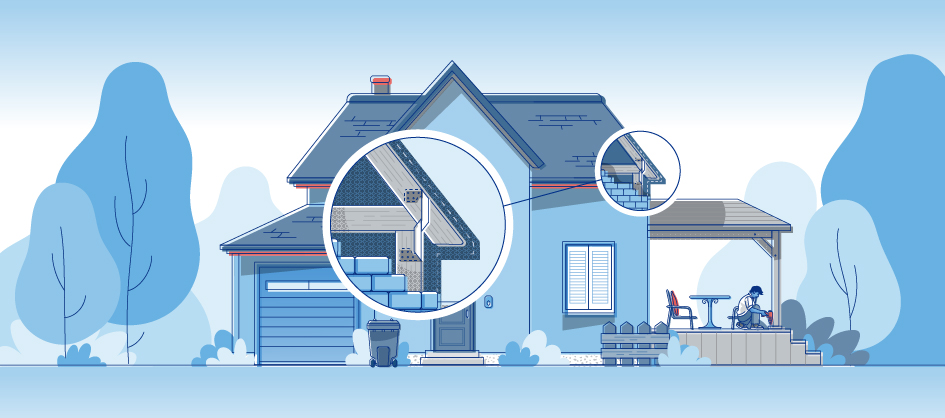All
Protecting your Home Against Severe Winds: Storm-proof your Roof
May 14, 2025
3 minute read

Extreme winds and tornadoes often conjure dramatic images of roofs, cars, and trees being lifted and hurled through the air.
This phenomenon is called uplift, an upward force created by strong winds as they flow over a structure. While it’s rare for severe winds to completely lift a well-built home, tornadoes and severe gusts can still cause significant structural damage, potentially lifting roofs or triggering wall collapses.
By being proactive in strengthening a home and reinforcing at-risk areas like roofs, porches and overhangs, homeowners can reduce the risk and inconvenience of wind-related damage and be ready for whatever nature brings.
Storm-proof the roof.
The roof is one of the most vulnerable parts of a home during a windstorm. The Institute for Catastrophic Loss Reduction (ICLR) suggests homeowners take the following steps to reinforce their roofs:
Inspect and upgrade materials: If the roof is aging or showing signs of wear, it may be time to consider re-roofing with a high wind-rated roof cover (shingles are rated from Class A through H, with H being the most wind resistant). When making any changes or reinforcements to a roof, the safest option is to work with a licenced and insured roofing company to get the job done.
Securely fasten roof sheathing: Using strong fastenings like ring-shank nails or screws instead of traditional smooth nails can increase the roof's resilience against uplift forces caused by strong gusts. Well-secured roof sheathing ensures the entire roof system remains intact and protects the home’s interior from severe weather-related damage.
Apply a secondary water barrier: The ICLR suggests using closed-cell urethane-based adhesive spray foam inside the attic. This foam bonds the sheathing to the roof structure, reducing the chances of panels detaching in high winds while also preventing water intrusion if the primary roof covering is compromised.
Use appropriate bracing and anchors: Roofs with gable ends are more susceptible to wind damage compared to hip or flat roofs due to their design and the way wind interacts with them. Adding braces and anchors to the roof trusses and at the gable ends provides extra support, reducing the likelihood of structural damage. Homeowners can also install galvanized metal hurricane straps to prevent uplift forces from detaching the roof during a storm.
Reinforce ridge and off-ridge vents.
Roof vents play a critical role in a home’s ventilation system, but during high winds, they can become weak points that allow wind-driven rain to enter the attic and cause damage. Homeowners can reinforce their vents by:
Choosing vents rated for high-wind applications and wind-driven rain resistance
Ensuring vents have a baffle or trip mechanism to redirect rain and keep water out
Securely fastening ridge vents to the roof deck to prevent them from being lifted by strong winds
Sometimes, the best course of action is to replace roof vents that are not designed for extreme weather conditions, with the assistance of a reputable roofing company.
Protect eaves and soffits.
The eaves of a home can expose the structure to wind-driven rain and flying debris. Here’s how the ICLR suggests reinforcing these areas for extra security:
Inspect and replace damaged soffits: Check for signs of wear, such as cracks or corrosion, and replace damaged sections with durable materials such as metal or reinforced vinyl, which are better suited to withstand extreme weather conditions.
Reinforce attachment points: Ensure soffits are securely fastened to the wall and eaves, using fasteners rated for high winds to prevent them from being dislodged. Long soffit panels (12 inches or more perpendicular to the wall) should have extra supports near the centre to prevent flexing and detachment.
Anchor with sealants: Applying sealant along the seams where the soffit meets the wall and trim helps to create a wind-resistant bond and reduces the risk of water intrusion and property damage.
Reinforce porches and overhangs.
These areas extend from a home and are often built with lighter materials, making them vulnerable to strong winds. To reinforce porches and overhangs and enhance their home’s total wind resistance, homeowners can:
Ensure porch columns are firmly anchored to both the ground and the roof structure to resist uplift forces
Use brackets to strengthen the connection between the porch roof and the main structure of the house
Reinforce the connection points between the overhang and the house, using additional bracing if necessary
Replace any loose, rusted, or weak nails and screws with stronger, wind-resistant fasteners
To protect your roof from severe winds, it's important to look beyond the home’s structure and consider the surrounding yard. Regularly trim nearby trees and shrubs, removing dead or weak branches to reduce the risk of windborne debris.
Learn about how to protect other areas of your home, including your doors, windows, and the yard.
Prevention: Your best defence.
By taking these preventive actions, homeowners can significantly reduce the risk of wind-related damage and the inconvenience of dealing with the aftermath of a storm. Strengthening your home today will give you comfort knowing that your property, family and possessions are protected from whatever nature has in store tomorrow.
Download PDF
This advice is intended to provide general information only and is not intended to provide legal or professional advice, or to be relied on in any dispute, claim, action, demand or proceeding. CAA Insurance Company or ICLR do not accept liability for any damage or injury resulting from reliance on this information.
